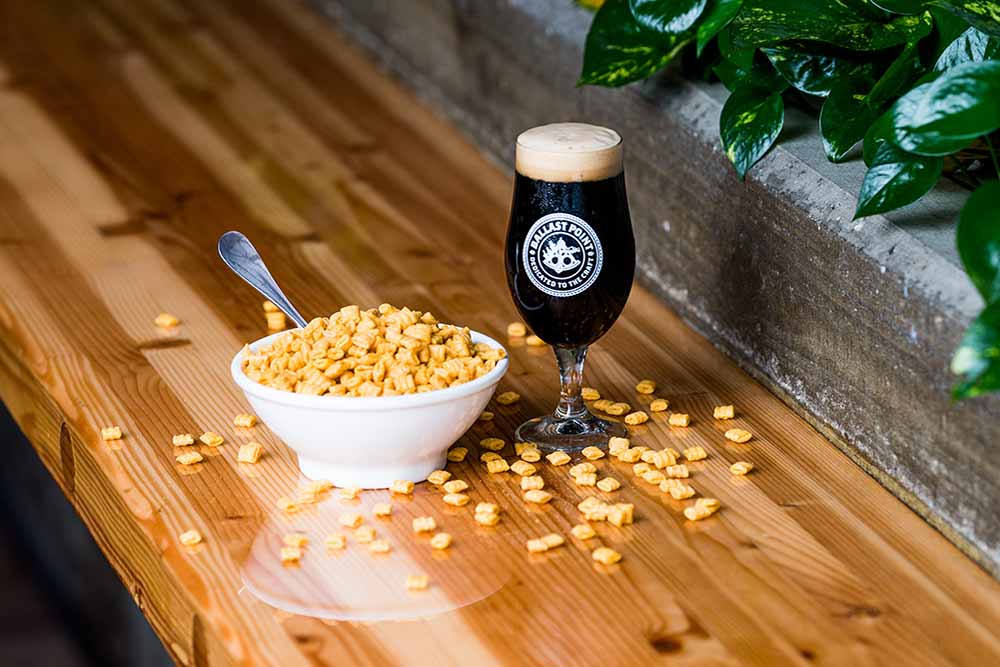
Who doesn’t like nostalgia? We all love traveling back to a simpler time when there wasn’t a care in the world. Certain cereals can trigger those thoughts of yesteryear, downing a bowl or two while reading the back of the box. Good times. Why not bring some of those memories into the present day? Many breweries have incorporated fun childhood cereals into their craft beer.
We’ve touched on other popular adjuncts used in beer, like fruity candy, chocolate, fruit purees, and honey—all popular flavor profiles in your favorite cereals—so we figured it’d be good to see how brewers incorporate cereal into beer. We chatted with Ballast Point and Pontoon Brewing who explained which type of cereal works best, how to incorporate cereal, and which beer style works best with cereal.
(Above photography courtesy of Ballast Point Brewing Company)
What We’ll Cover in This Piece:
Switching to Ollie Is Easier Than You Think
Breweries everywhere are discovering that Ollie is the affordable and better solution to spreadsheets and other brewing software. Plus, it's a breeze to switch over to Ollie!
Now it's your turn!
For a limited time, you can lock in our affordable price for 3 years!
Use the form below to learn more!
What Do the Experts Hope to Achieve by Adding Cereal to Beer?
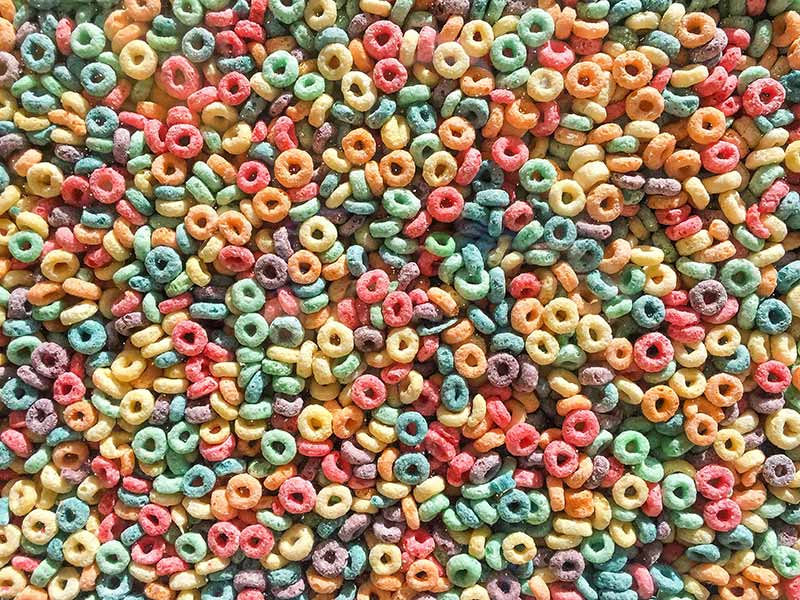
Photography courtesy of Etienne Girardet | Unsplash
Ballast Point Brand Ambassador and Brewer Jeff Lozano says that, ultimately, the point of using cereal is to add unique flavors, enhance sweetness, and potentially modify the body.
“Cereal can bring distinct notes like toasty grains, chocolate, fruity flavors, or even marshmallow sweetness, depending on the type used,” Lozano says. “Additionally, cereal can contribute to mouthfeel, adding creaminess or thickness.”
But Lozano adds an intangible that comes into play: “Honestly, sometimes it’s just a cool concept to create something fun that tastes good,” he says.
When Pontoon Brewing started using cereal in its beer in 2019, Co-Founder and CEO Sean O’Keefe says it was more of a joke. That brand, Rainbow Smiggles, is still around today and ranks as one of their most popular beers.
“It’s not a visual thing for the ‘Gram. It translates in the beer,” O’Keefe says. “For us, [cereal] provides a little bit of aroma. … Flavor gets muddled in there, but it doesn’t provide a lot of body or color in general. It adds a layer of complexity to the beer.”
O’Keefe sees the benefit of sentimentality, too.
“The Trix or Froot Loops® aroma is nostalgic,” O’Keefe says. “When I smell that, I think of hotel trips [and] eating breakfast in the lobby, or Saturday morning cartoons.”
O’Keefe adds, “Oftentimes you see it looked down upon by traditional brewers, but it feels to me a fun way to try something new and be creative.”
What Is the Best Type of Cereal to Use in the Brewing Process?
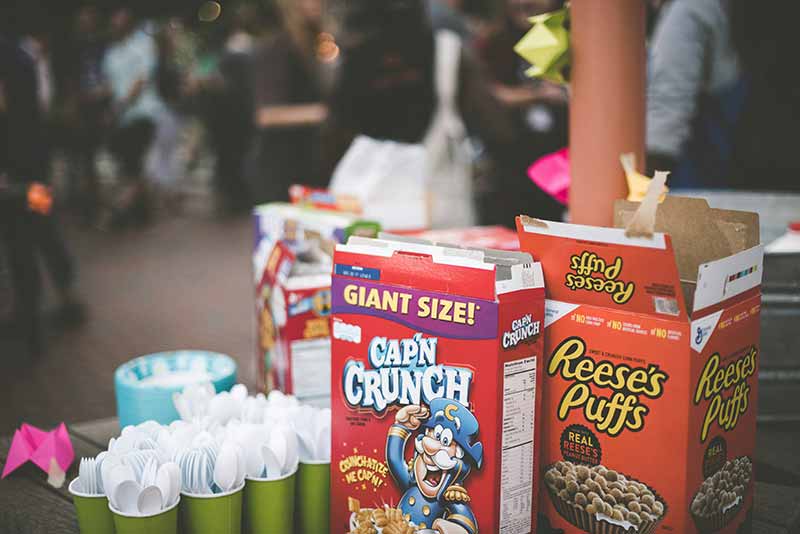
Photography courtesy of Samantha Gades | Unsplash
O’Keefe says they’ve worked with a number of different cereals with beer but believes he’s found the one that works best.
“Rice cereals tend to be better than corn cereals. Adds complexity to the beer. Fruity PEBBLES™, I prefer that over Trix when we compare them.”
Pontoon has used chocolate cereals as well, like Cocoa Puffs and Cocoa PEBBLES™.
O’Keefe prefers the rice cereals “because they dissolve faster,” he says. “Corn [cereals] have a hardness to them.” He adds that corn versions don’t dissolve as easily and can sometimes clog ports, which makes them more difficult to work with.
Lozano says Ballast Point went through rigorous trials to see which cereals would hold up.
“Cereals with strong, distinct flavors tend to work better, such as Cap’n Crunch®, Cocoa Puffs, Fruity PEBBLES™, or Cinnamon Toast Crunch™,” Lozano says of their findings. “Cereals that are sugar coated or have a unique flavor profile translate well too.”
When Do You Add Cereal in the Brewing Process?
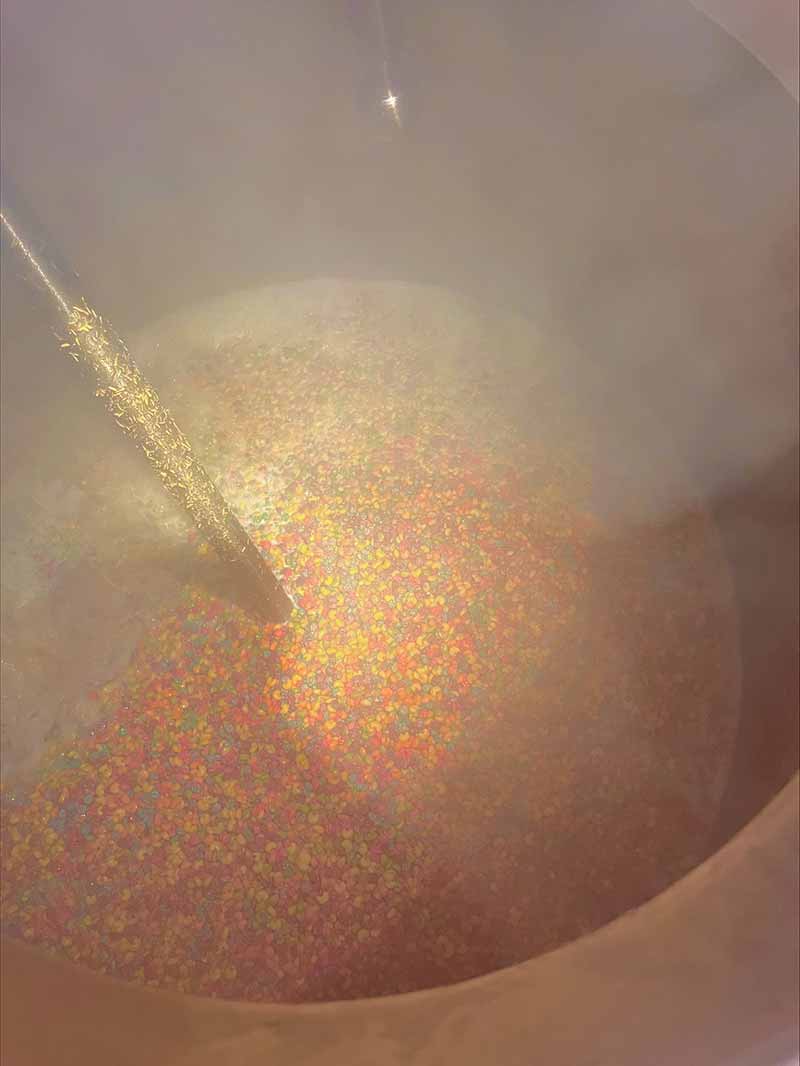
Photography courtesy of Pontoon Brewing
Lozano believes the best time to add the cereal is earlier.
“Usually during the mash, but it kinda depends on what you want the cereal to help with,” he says. “Adding it early allows the cereal’s sugars and flavors to break down and integrate with the malt. For some styles, the process is typically adding cereal in the secondary fermentation to enhance aroma or contribute to the flavor.”
O’Keefe says at Pontoon, they incorporate the cereal three times throughout the brewing process. He insists adding all the cereal is not a gimmick and that the finished product is “really cool.”
“We put some in the mash as is and we do cereal decoction mash style,” O’Keefe says. “We put cereal and a little base grain and pump it into the boil—I picked that up in homebrew days, it caramelizes the malt and adds depth of flavor, so we tried that with the cereal—the most complex part comes from that.”
O’Keefe adds, “And then the last part, we add a homemade [cereal syrup] mixture to make sure it comes through in the flavor in the back end. It adds authenticity.”
O’Keefe says figuring out the process of when to add the cereal took years of tinkering.
“First it wasn’t enough, and then it was too much,” he says. “We dialed it back to where we are now, and now we are done experimenting with [Rainbow Smiggles].”
They use a lot of different cereals at Pontoon. For some, they split the distribution.
“For something like Lucky Charms™, we put the cereal portion in the mash,” O’Keefe says, “and we put the marshmallows in the boil and secondary.”
How Much Cereal Should You Add?

Photography courtesy of Pontoon Brewing
In a ten-barrel batch of Rainbow Smiggles, O’Keefe says they incorporated 425 ounces of cereal. They determined this number through trial and error, as well as cost.
“We found that, at one point, it was diminishing rates of return,” O’Keefe says. “At 425 ounces, it breaks down to the right amount of flavor before it’s not doing anything for the beer itself.”
Adding too much in the mash will only go so far. O’Keefe says that you can’t really overdo it with the cereal, but the cost will get exorbitant.
“For how much a cereal costs per box, you’re not going to get enough from it,” he says. “If you do [add a lot], you’re spending way too much money and the beer won’t be profitable.”
Lozano says they use anywhere from one to three pounds of cereal per five gallons of beer.
“This amount is determined through trial and error,” Lozano says. “Starting small and gradually increasing the cereal content to achieve the right balance between beer characteristics and cereal flavor without overwhelming the brew.”
Unlike O’Keefe, Lozano feels you can overdo it with the cereal, resulting in off flavors, excessive sweetness, or a stuck mash.
“It’s important to balance the cereal with the grain bill and keep an eye on mash efficiency, as some cereals contain oils or sugars that can affect fermentation,” Lozano says. “Remember, especially if doing it post knockout, you can always add, but you can’t go back.”
Which Beer Style Best Showcases Cereal?
Lozano says that cereal works really well in milk stouts and some IPAs, but Ballast Point’s golden ticket was with a porter.
“The sweetness and flavors from the cereal complement darker malts and lactose in stouts or porters,” Lozano says. “We really haven’t messed with cereal in sours, though fruit-flavored cereals can add an interesting twist with them.”
O’Keefe says sours or fruited ale are the way to go for cereal in beers.
“Those are the ones without as many competing flavors like a stout,” O’Keefe says. “Although we have had some success with browns and stouts.”
O’Keefe adds, “We have more of a clean slate with a sour. Blank slate and adding flavor to give it some profile. The flavor is more likely to come through. [But with] bigger, more robust styles, it’s harder to come through.”
O’Keefe says they tried an IPA version of “Smiggles,” but the hops muted the cereal. They had some success with a blonde ale, which resulted in something similar to a shandy.
“The blonde was a light palate, and easy to add flavor to the surface without bastardizing the beer,” he says.
Two Great Examples of Cereal in Beer
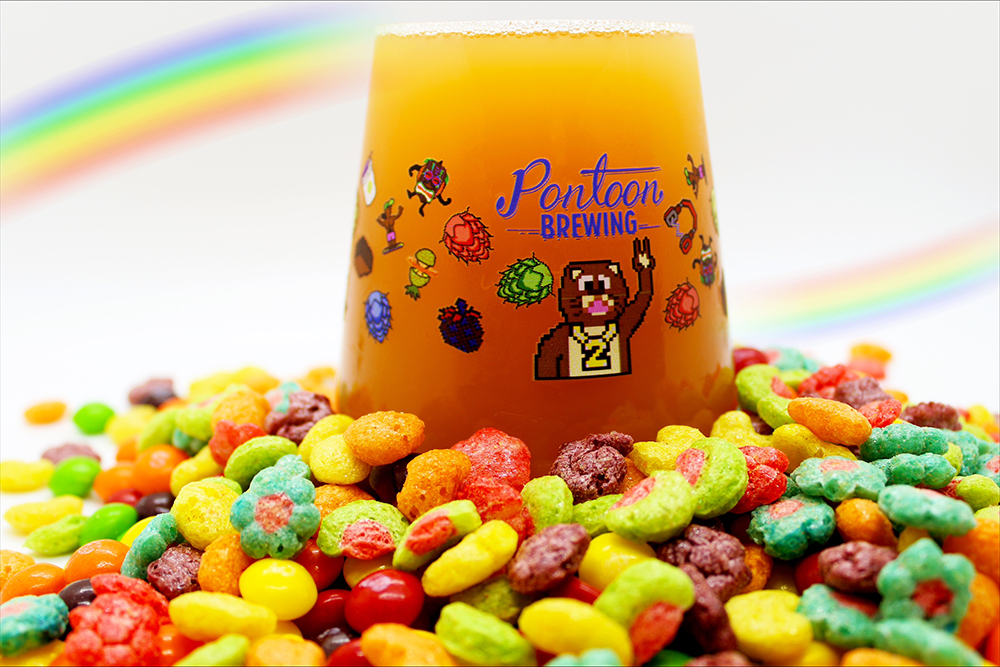
Photography courtesy of Pontoon Brewing
Victory at Sea from Ballast Point is a 10% ABV imperial porter made with coffee, vanilla, and a “hefty dose” of Cap’n Crunch® cereal.
“It started as a cask and helped usher in our annual Victory at Sea Day that showcases a variety of different renditions of the beer,” Lozano says.
Rainbow Smiggles is O’Keefe’s favorite beer Pontoon makes with cereal. The 7% ABV sour beer includes three hundred pounds of Skittles and more than one hundred boxes of Trix cereal.
“It’s just unique,” says O’Keefe. “Such a nostalgic flavor, and it translates pretty easily into the beer.”



